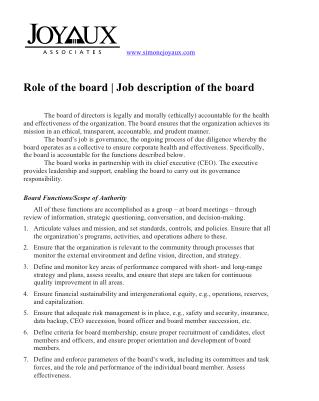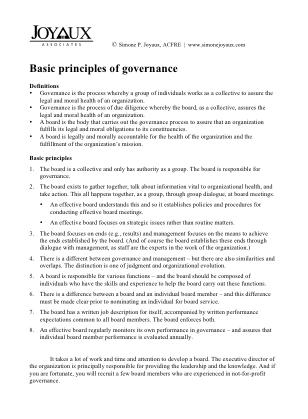Assessing your board’s governance capacity
- Written by
- Simone Joyaux
- Added
- June 19, 2014

Here’s my definition of corporate governance, the work your board does:
The process whereby a group of people ensure the health and effectiveness of the corporation, whether for-profit or nonprofit.
Here are some of my basic principles of corporate governance.
- The board is a collective and only has authority as a group.
- The board exists to get together, talk about information vital to corporate health and to take action. This all happens together, through group dialogue at board meetings. In fact, corporate governance only happens when the board is together.
See the list of governance principles and a job description for the board on the right.
I think that all staff working closely with the board – for example, the chief executive officer, chief financial officer, chief development officer – must be highly knowledgeable about governance. They enable the board (and its individual board members) to do good governance.
I recommend that every board evaluate its governance performance at least every other year, if not every year. I use this assessment when organisations hire me to evaluate and help improve the board. The assessment is step one. My analysis of the results and reporting my findings to the full board is step two. And step three: I work with the organisation to make all the improvements identified through the assessment.

Each board member completes the assessment individually. I also expect each staff person who works closely with the board and its committees to complete the assessment.
Tabulate the board member responses together. Also tabulate the staff responses together. In my experience, the staff responses are often more accurate and real than the board members’ responses. I would expect this because I expect the staff to be highly knowledgeable about governance. That’s just one of the many jobs of the CEO and her senior management.
The governance committee reviews the tabulated results – and compares the perceptions of staff and board members. The governance committee shares the results with the board for a conversation. Then the governance committee outlines steps for improvement and engages the board in the improvement process.
I’ve developed the assessment shown on the right over 20 years – through my own readings and experience, by looking at other tools and adjusting them. I periodically update the assessment with new thinking. In essence, this assessment proposes a set of standards for good corporate governance.
The response choices are:
- ‘Yes’: our organisation performs according to this standard.
- ‘Needs improvement: our organisation is making progress adhering to this standard but we still need to improve to achieve the standard.
- ‘No’: our organisation does not adhere to this standard.
- ‘Don’t know’: the respondent doesn’t know if the organisation adheres to the standard.
Often, I’m most interested in the ‘don’t know’ responses. I believe that every board member should know how the board performs compared to the standards. The reasons for ‘don’t know’ might be
- Irregular attendance at board meetings.
- Weak screening of board member candidates and weak orientation for newly elected members.
- Insufficient setting of context/reminding/explaining at board meetings.
Here are some of my favourite standards:
- The board member recruitment process considers issues of diversity, e.g. gender, generation, sexual orientation, ethnicity, socioeconomics, skills, etc when identifying candidates for board membership.
- Bylaws limit tenure and ensure rotation of board members, and the board enforces these. And another one of my favourite standards is that at least 2/3 of seated board members attend each board meeting.
- The board discusses the types of behaviour that contribute to group effectiveness, seeks individuals who behave accordingly and avoids individuals whose behaviour negatively affect the group.
- The organisation’s chief executive officer (CEO) participates in the recruitment of board members, their development and evaluation.
- Regular performance evaluation of board members distinguishes between those who should be invited to continue service and those who should be thanked and released. Click here to find out how to fire a lousy board member.
- Board and staff acknowledge that differences (e.g., ethnicity/race, class, gender, sexual orientation and so forth) contribute to privilege and may produce power dynamics that affect group effectiveness. This issue is addressed.
- Board and staff acquire cultural competence, e.g., learning new skills to communicate and work effectively across differences such as gender, socioeconomic, class and so forth.
- The board ensures an appropriate balance between investment in mission/programme and infrastructure.
- The board recognises that the CEO serves as the organisation’s chief spokesperson.
- The board holds the CEO accountable to serve as the primary resource for understanding and promoting good governance and effectively enabling the board to fulfil its governance obligations.
- The board understands that corporate governance is a collective act and happens only when the board is together, hence the stringent requirement for attendance, preparation and participation.
- Board officers – including the board chair – understand that they have no more authority than any other member and behave accordingly.
- Board members understand that conversation is a core business practice and foster group dialogue, diverse opinions, candour and participation by all.
- The board distinguishes between management and governance and discusses and resolves any such conflicts in partnership with the CEO.
- The board doesn’t allow any individual or entity to limit the board’s authority.
- Board members know the difference between board membership and working as a volunteer within the organisation and behave accordingly.
- The CEO – providing guidance to the board – knows how to translate the board’s job description into due diligence activities carried out at board meetings.
- Together, the board chair and CEO prepare agendas that reflect the agency’s priorities, fulfil due diligence requirements and engage the board in its appropriate functions.
- Board members are well prepared for each meeting, focus on strategic issues and contribute meaningful questions and comments to board conversation.
- The board decides whether an executive committee (or some other similar committee) adds sufficient value to compensate for potential disempowerment of the board.
- The board’s governance committee discusses attendance and performance with board members who are absent or inactive – with the goal of enhancing performance, enhancing attrition, or thanking and releasing.
Yes, this governance self-assessment is fairly long. It probably takes 15 minutes to complete. I expect every board member to complete the survey – and that does happen! I find it distressing – and rather enlightening – if some board members don’t complete the assessment. How is that acceptable?



















